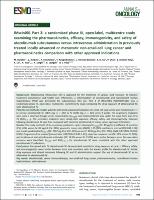| dc.contributor | Vall d'Hebron Barcelona Hospital Campus |
| dc.contributor.author | Burotto, Mauricio |
| dc.contributor.author | Zvirbule, Z. |
| dc.contributor.author | Mochalova, A. |
| dc.contributor.author | Runglodvatana, Y. |
| dc.contributor.author | Herraez-Baranda, L. |
| dc.contributor.author | Liu, S.N. |
| dc.contributor.author | FELIP, ENRIQUETA |
| dc.date.accessioned | 2023-08-02T07:37:21Z |
| dc.date.available | 2023-08-02T07:37:21Z |
| dc.date.issued | 2023-08 |
| dc.identifier.citation | Burotto M, Zvirbule Z, Mochalova A, Runglodvatana Y, Herraez-Baranda L, Liu SN, et al. IMscin001 Part 2: a randomised phase III, open-label, multicentre study examining the pharmacokinetics, efficacy, immunogenicity, and safety of atezolizumab subcutaneous versus intravenous administration in previously treated locally advanced or metastati. Ann Oncol. 2023 Aug;34(8):693–702. |
| dc.identifier.issn | 0923-7534 |
| dc.identifier.uri | https://hdl.handle.net/11351/10031 |
| dc.description | Cáncer de pulmón de células no pequeñas; Farmacocinética; Subcutáneo |
| dc.language.iso | eng |
| dc.publisher | Elsevier |
| dc.relation.ispartofseries | Annals of Oncology;34(8) |
| dc.rights | Attribution-NonCommercial-NoDerivatives 4.0 International |
| dc.rights.uri | http://creativecommons.org/licenses/by-nc-nd/4.0/ |
| dc.source | Scientia |
| dc.subject | Avaluació de resultats (Assistència sanitària) |
| dc.subject | Pulmons - Càncer - Tractament |
| dc.subject | Injeccions hipodèrmiques |
| dc.subject | Anticossos monoclonals - Ús terapèutic |
| dc.subject.mesh | Carcinoma, Non-Small-Cell Lung |
| dc.subject.mesh | /drug therapy |
| dc.subject.mesh | Injections, Subcutaneous |
| dc.subject.mesh | Antibodies, Monoclonal |
| dc.subject.mesh | Treatment Outcome |
| dc.title | IMscin001 Part 2: a randomised phase III, open-label, multicentre study examining the pharmacokinetics, efficacy, immunogenicity, and safety of atezolizumab subcutaneous versus intravenous administration in previously treated locally advanced or metastatic non-small-cell lung cancer and pharmacokinetics comparison with other approved indications |
| dc.type | info:eu-repo/semantics/article |
| dc.identifier.doi | 10.1016/j.annonc.2023.05.009 |
| dc.subject.decs | carcinoma de pulmón de células no pequeñas |
| dc.subject.decs | /farmacoterapia |
| dc.subject.decs | inyecciones subcutáneas |
| dc.subject.decs | anticuerpos monoclonales |
| dc.subject.decs | resultado del tratamiento |
| dc.relation.publishversion | https://doi.org/10.1016/j.annonc.2023.05.009 |
| dc.type.version | info:eu-repo/semantics/publishedVersion |
| dc.audience | Professionals |
| dc.contributor.organismes | Institut Català de la Salut |
| dc.contributor.authoraffiliation | [Burotto M] Centro de Investigación, Clínica Bradford Hill, Santiago, Chile. [Zvirbule Z] Latvian Oncology Center, Riga Eastern Clinical University Hospital, Riga, Latvia. [Mochalova A] Department of Antitumor Drug Therapy, MEDSI Clinical Hospital, Moscow, Russia. [Runglodvatana Y] Faculty of Medicine, Vajira Hospital, Bangkok Metropolitan University, Bangkok, Thailand. [Herraez-Baranda L] Product Development Medical Affairs Oncology, F. Hoffmann-La Roche Ltd, Basel, Switzerland. [Liu SN] Clinical Pharmacology, Genentech, Inc., South San Francisco, USA. [Felip E] Servei d’Oncologia Mèdica, Vall d’Hebron Hospital Universitari, Barcelona, Spain. Clinical Research Department, Vall d’Hebron Institute of Oncology (VHIO), Barcelona, Spain |
| dc.identifier.pmid | 37268157 |
| dc.rights.accessrights | info:eu-repo/semantics/openAccess |

 Área privada
Área privada Contacto
Contacto







